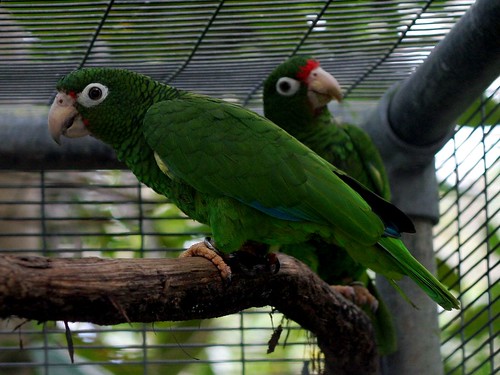 Puerto Rican parrots at Rio Abajo (photo by Brendan Borrell)Last Friday, David Logue, an old friend and biologist from the University of Puerto Rico-Mayagüez took me out to see the island’s imperiled parrots and explain how deciphering their duets could improve efforts to save them.
Puerto Rican parrots at Rio Abajo (photo by Brendan Borrell)Last Friday, David Logue, an old friend and biologist from the University of Puerto Rico-Mayagüez took me out to see the island’s imperiled parrots and explain how deciphering their duets could improve efforts to save them.
The Puerto Rican parrot (Amazona vittata) is the only extant parrot native to the United States and is considered one of the most endangered birds in the world. When Christopher Columbus arrived on the island in 1493, there were probably a million Iguaca–as the locals called them–but as colonists chopped down forests, their numbers plummeted. By 1968, just two dozen animals remained.
That’s when the U.S. Forest Service launched its captive breeding project in the El Yunque National Forest. Then, in 1989, the Puerto Rican Department of Natural Resources got in on the act, establishing an aviary at the Rio Abajo State Forest where Logue has brought me to meet his soon-to-be graduate student, Brian Ramos. For the last 11 years, Ramos has been working at the aviary and has nearly mastered the art of avian matchmaking.
After disinfecting our feet, Ramos guided us out a muddy track to the flight cages where the emerald-feathered birds are allowed to mingle. Birds bond with one another by performing a duet–a song-like conversation between the male and female–and Ramos allows the couples with most enthusiastic duets to mate with one another. Currently, the aviary has 198 birds in captivity and is pumping out as many as 30 new chicks each year.
While Ramos has a great record, he thinks he can do better. After all, just 68 birds currently survive in the wild. “We have many fertile pairs, but not all of them are able to raise their chicks,” he says. “I want to have a better understanding of which birds to choose for mating.”
So in the fall, Logue and Ramos will begin filming parrot pairs and recording their duets together to look for subtle clues about how well they are able to work together. Logue, who has studied such duets in black-bellied wrens in Panama, says a key variable in these duets is how quickly the female responds to the male and vice versa. To me, it just sounds like a bunch of random squawking, but Logue insists there’s a logic to this cacophony.